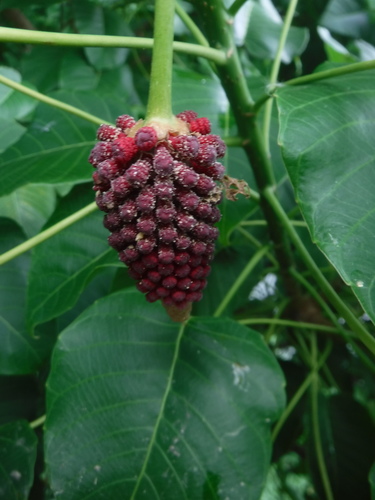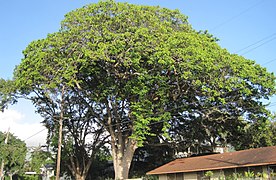Sandbox Tree
Search
Wikipedia
| Hura crepitans | |
|---|---|

| |
|
Scientific classification | |
| Kingdom: | Plantae |
| Clade: | Tracheophytes |
| Clade: | Angiosperms |
| Clade: | Eudicots |
| Clade: | Rosids |
| Order: | Malpighiales |
| Family: | Euphorbiaceae |
| Genus: | Hura |
| Species: |
H. crepitans
|
| Binomial name | |
|
Hura crepitans | |
| Synonyms[1] | |
Hura crepitans, the sandbox tree,[2] also known as possumwood and jabillo, is an evergreen tree of the spurge family (Euphorbiaceae), native to tropical regions of North and South America including the Amazon rainforest. It is also present in parts of Tanzania, where it is considered an invasive species.[3] It can be recognized by its smooth brown bark covered in many dark, pointed spines which have led to its being nicknamed monkey no-climb. Because its fruit explodes when ripe, it has also received the colloquial nickname the dynamite tree.[4]
Description
The sandbox tree can grow to 60 metres (200 ft),[5] and its large ovate leaves grow to 60 cm (2 ft) wide. They are monoecious, with red, un-petaled flowers. Male flowers grow on long spikes, while female flowers grow alone in axils. The sandbox tree's fruiting bodies are large capsules which can explode when ripe, splitting into segments and launching seeds at 70 m/s (250 km/h; 160 mph).[4] One source states that ripe capsules catapult their seeds as far as 100 m (330 ft).[6] Another source states that seeds are thrown as far as 45 m (150 ft) from a tree, averaging about 30 m (100 ft).[5]
Its fruits are pumpkin-shaped capsules, 3–5 cm (1–2 in) long, 5–8 cm (2–3 in) diameter, with 16 carpels arranged radially. Its seeds are flattened and about 2 cm (3⁄4 in) diameter.
Habitat
This tree prefers wet soil, and partial shade or partial to full sun. It is often cultivated for shade.
Uses
Fishermen have been said to use the milky, caustic sap from this tree to poison fish.[7] The Caribs made arrow poison from its sap.[8] The wood is used for furniture under the name "hura". Before more modern forms of pens were invented, the trees' unripe seed capsules were sawn in half to make decorative pen sandboxes (also called pounce pots), hence the name 'sandbox tree'.
Gallery
Large sandbox tree in Honolulu
Hura crepitans in Vietnam
Hura crepitans in Saint John, U.S. Virgin Islands
References
- ^ "The Plant List: A Working List of All Plant Species".
- ^ "Hura crepitans". Germplasm Resources Information Network (GRIN). Agricultural Research Service (ARS), United States Department of Agriculture (USDA). Retrieved 24 December 2017.
- ^ "Factsheet – Hura crepitans (Sandbox Tree)".
- ^ a b Vogel, Steven (March 2008). "The Flight of the Seed of Hura crepitans" (PDF). Archived from the original (PDF) on 2013-06-08.
- ^ a b Swain, M. D.; Tom Beer (1977). "Explosive Seed Dispersal in Hura crepitans L. (Euphorbiaceae)". New Phytologist. 78 (3): 695–708. doi:10.1111/j.1469-8137.1977.tb02174.x. JSTOR 2434538.
- ^ Feldkamp, Susan (2006). Modern Biology. United States: Holt, Rinehart, and Winston. p. 618.
- ^ Smithsonian Institution.; Institution, Smithsonian (19 February 2019). "Bulletin /". biodiversitylibrary.org. G.P.O. Retrieved 19 February 2019.
- ^ Jones, David E (2007). Poison Arrows: North American Indian Hunting and Warfare. University of Texas Press. ISBN 978-0-292-71428-1.
External links
| Wikimedia Commons has media related to Hura crepitans. |







